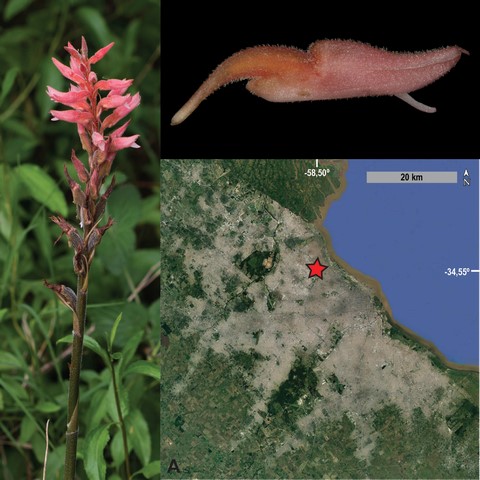La aparición de la orquídea Sacoila lanceolata (Orchidoideae: Cranichideae: Spiranthinae) en el ejido de la Ciudad Autónoma de Buenos Aires
DOI:
https://doi.org/10.30972/bon.3115804Palabras clave:
Chloraea membranacea, especie bandera, Orchidaceae, reserva urbanaResumen
A pesar de que la ciudad de Buenos Aires es un territorio antropizado en su totalidad existen reductos de vegetación que albergan plantas nativas de ocurrencia espontánea. Aquí informamos el registro de la orquídea terrestre Sacoila lanceolata (Aubl.) Garay dentro del perímetro de la ciudad. La misma fue hallada en el Arboretum del Parque Sarmiento, una clausura reciente de 1000 m2 donde son conservadas especies nativas de la región ribereña bonaerense. Este registro ocurre en el extremo austral de distribución de la especie, donde las demás citas cercanas se ubican a más de 200 km de distancia. Dado lo inesperado de este registro discutimos la naturaleza de su aparición y su relevancia como potencial especie bandera.Descargas
Citas
Adamowski, W. (2006). Expansion of native orchids in anthropogenous habitats. Polish Botanical Studies, 22, 35–44.
Barthlott, W., B. Grobe-Veldmann, & N. Korotkova. (2014). Orchid seed diversity: a scanning electron microscopy survey. Englera 32.
BBC. (2021). Rare orchids found in City of London bank's rooftop garden. Disponible: https://www.bbc.com/news/uk-england-london-57439921 (Consulta 10/08/2021).
Chase, M. W., Cameron, K. M., Freudenstein, J. V., Pridgeon, A. M., Salazar, G., van den Berg, C., & Schuiteman, A. (2015). An updated classification of Orchidaceae. Botanical Journal of the Linnean Society, 177(2), 151–174.
https://doi.org/10.1111/boj.12234
Cohen, I. M., & Ackerman, J. D. (2009). Oeceoclades maculata, an alien tropical orchid in a Caribbean rainforest. Annals of Botany, 104(3), 557–563. https://doi.org/10.1093/aob/mcn191
Correa, N.M. (1955). Las orquídeas argentinas de la Tribu Polychondreae Schlechter: Subtribu Spiranthinae Pfitzer. Darwiniana 11(1): 24–88
Correa, N.M., M. Múlgura & A. Sanguinetti. en prensa. Orchidaceae. En: Bacigalupo, N., M. Múlgura & M. Ponce (eds.), Flora Ilustrada de Entre Ríos (Argentina). Parte I: Pteridófitas, Gimnospermas y Monocotiledóneas (sin las Gramíneas). Instituto de Botánica Darwinion, Buenos Aires.
Croteau, E. K. (2010). Causes and Consequences of Dispersal in Plants and Animals. Nature Education Knowledge 3(10):12.
Guimarães, L.R.S. (2014). Filogenia e citotaxonomia do clado Stenorrhynchos (Spiranthinae, Cranichideae, Orchidoideae, Orchidaceae). Tesis doctoral. Instituto de Botânica, São Paulo, 101 pp.
Haene, E. (2020). Biocorredores de la Ciudad Autónoma de Buenos Aires, un modelo demostrativo para la Argentina. Universidad de Belgrano. Buenos Aires, 145 pp.
Hedrén, M., Olofsson, S. N., & Paun, O. (2018). Orchid colonization: multiple parallel dispersal events and mosaic genetic structure in Dactylorhiza majalis ssp. lapponica on the Baltic island of Gotland. Annals of Botany, 122(6), 1019–1032. https://doi.org/10.1093/aob/mcy111
Home, R., C. Keller, P. Nagel, N. Bauer & M. Hunziker. (2009). Selection criteria for flagship species by conservation organizations. Environmental Conservation, 36(2), 139-148. https://doi.org/10.1017/S0376892909990051
Johnson, A.E. (2001). Las Orquídeas del Parque Nacional Iguazú. LOLA, Buenos Aires, LOLA, 201 pp.
Pérez, L.M., E.M. Pessoa & M. Alves. (2020). Lista comentada de Orchidaceae en Uruguay y su distribución en ambientes y eco-regiones. Lankesteriana 20(3):359–395. https://doi.org/10.15517/lank.v20i3.45193
Massi, C. (2021). Registro de Sacoila lanceolata. Disponible: https://www.inaturalist.org/observations/45556785 (Consulta 10/08/2021).
Matteucci, S.D. & M. Falcón. (2012). Efectos de la urbanización sobre la biodiversidad. En: Athor, J. (Ed.), Buenos Aires, la historia de su paisaje natural, pp. 272–291. Fundación de Historia Natural Félix de Azara y Universidad Maimónides. Buenos Aires.
Ministerio de Desarrollo Urbano y Transporte. Gobierno de la Ciudad de Buenos Aires. (2021). Fotografías Aéreas. Disponible: http://ssplan.buenosaires.gob.ar/webfiles/mapa_aereas2 (Consulta 10/08/2021).
Malagnino, E. 2007. Geomorfología. En: Nabel, P. & D. Kullock (eds.), Atlas Ambiental de Buenos Aires. Museo Argentino de Ciencias Naturales, CONICET y Gobierno de la Ciudad de Buenos Aires.
Neto, L. M., Miranda, M. R., & Cruz, D. (2011). Zeuxine strateumatica (Orchidaceae) goes south: a first record for Brazil. Kew Bulletin, 66(1), 155–158.
https://doi.org/10.1007/s12225-011-9271-2
Löki, V., Molnár V., A., Süveges, K., Heimeier, H., Takács, A., Nagy, T., Fekete, R., Lovas-Kiss, Á., Kreutz, K. C. A. J., Sramkó, G., & Tökölyi, J. (2019). Predictors of conservation value of Turkish cemeteries: A case study using orchids. Landscape and Urban Planning, 186, 36–44.
https://doi.org/10.1016/j.landurbplan.2019.02.016
Piñeiro, A.G. (2001). El Museo Saavedra en sus primeros 80 años. Historias de la ciudad, Año 3, Nro 12.
Salazar, G. A. (2003). Spiranthinae. En: Pridgeon, A. M., P. J. Cribb, M. W. Chase & F. N. Rasmussen (eds.), Genera Orchidacearum vol.3 Orchidoideae part 2, Vanilloideae, pp. 164–278. Oxford University Press, New York.
Salazar, G. A., Batista, J. A. N., Cabrera, L. I., van Den Berg, C., Whitten, W. M., Smidt, E. C., Buzatto, C. R., Singer, R. B., Gerlach, G., Jiménez-Machorro, R., Radins, J. A., Insaurralde, I. S., Guimarães, L. R. S., de Barros, F., Tobar, F., Linares, J. L., Mújica, E., Dressler, R. L., Blanco, M. A., … Chase, M. W. (2018). Phylogenetic systematics of subtribe Spiranthinae (Orchidaceae: Orchidoideae: Cranichideae) based on nuclear and plastid DNA sequences of a nearly complete generic sample. Botanical Journal of the Linnean Society, 186(3), 273–303.
https://doi.org/10.1093/botlinnean/box096
Sanguinetti, A., Buzatto, C. R., Pedron, M., Davies, K. L., Ferreira, P. M. D. A., Maldonado, S., & Singer, R. B. (2012). Floral features, pollination biology and breeding system of Chloraea membranacea Lindl. (Orchidaceae: Chloraeinae). Annals of Botany, 110(8), 1607–1621.
https://doi.org/10.1093/aob/mcs221
Singer, R. B. & M. Sazima. (2000). The pollination of Stenorrhynchos lanceolatus (Aublet) L. C. Rich. (Orchidaceae: Spiranthinae) by hummingbirds in southeastern Brazil. Plant Systematics and Evolution 223:221–227
https://doi.org/10.1007/BF00985281
Sirolli, H., & Kalesnik, F. A. (2015). Composición, estructura y tendencia sucesional de un bosque de aliso de río (Tessaria integrifolia), en la Reserva Ecológica Costanera Sur, Ciudad Autónoma de Buenos Aires, Argentina. Historia Natural, Tercera Serie, 5(1), 109-124.
Thiers, B. Index Herbariorum: a global directory of public herbaria and associated staff. New York Botanical Garden's Virtual Herbarium, http://sweetgum.nybg.org/ih
Vanden Broeck, A., Van Landuyt, W., Cox, K., De Bruyn, L., Gyselings, R., Oostermeijer, G., Valentin, B., Bozic, G., Dolinar, B., Illyés, Z., & Mergeay, J. (2014). High levels of effective long-distance dispersal may blur ecotypic divergence in a rare terrestrial orchid. BMC Ecology, 14.
https://doi.org/10.1186/1472-6785-14-20
WCSP. (2021). World Checklist of Selected Plant Families. Royal Botanic Gardens, Kew. Disponible: http://wcsp.science.kew.org (Consulta 10/08/2021).

Publicado
Cómo citar
Número
Sección
Licencia
Declaration of Adhesion to Open Access
- All contents of Bonplandia journal are available online, open to all and for free, before they are printed.
Copyright Notice
- Bonplandia magazine allows authors to retain their copyright without restrictions.
- The journal is under a Creative Commons Attribution 4.0 International license.














.jpg)


